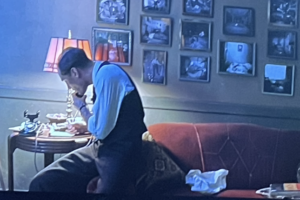Choosing Artwork for my clients can be the most difficult of my tasks. Artwork, it seems, is a very personal matter; people don’t want just anything hanging on their walls – they want artwork that speaks to them or means something special for them.
For people who truly love art, a meaningful collection is a lifetime pursuit, not a one-shot decorating project!
Choose Original Art
My grandfather on my father’s side was a fine arts painter who was born in Montreal, the eleventh of thirteen children, into a family of modest means. Needless to say, painting was not considered a practical career option, nonetheless, my grandfather pursued his passion all the way to Paris where he studied art at the Academie St. Julien. Paris, in the early 1900’s, was the place to be in the art world; impressionism had flowered, Picasso and Braque were delving into cubism, and the vitality of bohemian culture was never stronger.
To this day, I am the beneficiary of my grandfather’s legacy: he generously shared his love of art with me and I enjoy covering my walls not only with his impressionist style paintings but with abstract paintings, a few from the schools of the old masters and various works by my artist friends. To me, a house is not livable until the artwork is hung. All of this is leading me to say that as far as I’m concerned, reproduction artwork is not satisfactory. I want the real thing, the original work, the touch of the human hand, the evidence of the artist working with the medium to create his vision. Although the image may be accurately transferred in a reproduction piece – the flat, completely regular surface doesn’t tell the story of the energy and passion that created it.
Okay, I’m not against putting some reproduction prints in a powder room to brighten up the space, but full-size reproductions to hang in the living room – never. Giclee prints have become very popular. This a process that prints oil paintings on canvas so that the result has the texture of the canvas (but not the brushstroke); they are an admirable attempt at copying but can look too slick. Prints on paper are usually bad to begin with and the ink fades over time wreaking havoc with the color that was probably off to begin with.
My recommendation is this: support local artists. If you open your eyes there is an abundance of local talent: galleries, framing shops and restaurants regularly show local artists’ work; art shows are numerous. I was delighted to see throngs of art enthusiasts visiting the annual Armonk Art Show the last weekend in September. It’s fun to see what contemporary artists are doing and to engage them in talking about their work.
Some work was very affordable, even on a modest budget. Photographs (not to be confused with reproduction prints) are a good place to start. One can often buy some very wonderful images – frames included – quite reasonably.
Matting and Framing
Take your artwork to a competent framer and seek their advice as to how to frame it. If you have a significant framing project, most framers will be willing to visit your home and offer advice on where to hang and how to frame your artwork. However, if you are only framing one piece you will most likely have to determine how you want it framed so that it looks good on your wall.
I leave it to the framers to explain all the possible options, but here a few things to keep in mind: (1) You can increase the size and importance of a photograph, print or watercolor by using a dramatically large mat –say, put a tiny 3" x 4" watercolor in a 9" x 12" mat. (2) You can change the overall shape of the framed piece by extending the mat – for example, a square photograph can be set into a vertical format mat – a large expanse of mat on the bottom will give you a rectangular finished piece. (3) Mats can be enhanced with color bands, or pieces can be double matted with different color mats – a good way to enhance the color in the painting or make the piece work better in the room. (4) Dark mats carry a lot of visual weight, they can be used effectively to increase the impact of a smaller piece. (5) Abstract works usually look best with a minimal frame. (6) When framing traditional representational oil paintings I like a large important frame with a concave edge that draws the eye into the picture plane.
Hanging your Artwork
On one of my first decorating jobs, I bought some charming framed silhouettes for a young girl’s room and left it to her father to hang them. I explained that I wanted them hung over the nightstands but I mistakenly neglected to give him the height; he hung them way too high leaving a mighty yawning gap between the artwork and the nightstand, and certainly too high for the little girl to see them.
Art looks best when it is placed in close relation to the furniture and the architecture. We all know this on some level, even the least visually acute people know to hang the traditional painting above the sofa. But it doesn’t stop there; all artwork needs to be grounded. One client had three modestly-sized oil paintings that she wanted me to place in her cavernous living room. She wanted me to work magic to "fill up" the empty wall space but what I did was to place one above a small console table with a lamp and two others above the side chairs that flanked a large buffet. This created pleasing arrangements within the room – far more satisfying to compose small groups than to have artwork "hanging out in space" on a large expanse of wall.
Mirrors , with few exceptions, should be hung at eye level, preferably where they will reflect a nice view or light from a window, but artwork has more flexibility in height. A good rule of thumb is to hang artwork so that it mimics the shape of the space, i.e. hang a vertical piece on a vertical wall or hang paintings "step fashion" going up a stairwell.
Groupings of art can be a wonderful way to decorate – a lackluster room can take on a whole new dimension with a fabulous "gallery grouping." One approach is to format every piece in the same way. For example, I had a group of 24 family photos framed in the same format and size for one of my clients. We hung them "grid style" over a console in her bedroom that features a soaring ceiling. Although the result was striking, I must warn you that, since the frames were identical, the photos had to be hung in perfect alignment and that was a challenge!
Another approach to the "gallery grouping" is to use all different kinds and sizes of art to create a grouping on the wall. To do this successfully, first, assess your intended wall location and decide on the size and shape of the entire grouping. Then, map out the shape on the floor and then arrange your pieces within the shape to create a pleasing composition. Finally – and this can be tricky – transfer your composition to the wall!
One final note: Some of my clients are of the engineering mentality and they measure a space intending to place artwork rigidly in the middle of a space or exactly symmetrically. Measuring is important to be sure, but my advice is to "eyeball" your picture hanging as well, because visual balance doesn’t always coincide with perfect measurements. I wish you years of happy art collecting.
Barbara Sternau is an Interior Designer with offices at 37 Main St., Tarrytown, NY bsternau@optonline.net






